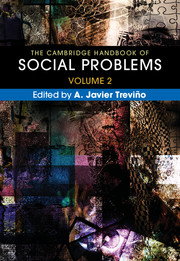Book contents
- The Cambridge Handbook of Social Problems
- The Cambridge Handbook of Social Problems
- Copyright page
- Contents
- About the Contributors
- Introduction
- Part I Problems Related to Health, Safety, and Security
- Part II Problems Related to Crime and Violence
- Chapter 12 The Problem of Crime
- Chapter 13 Corporate Malfeasance as a Social Problem
- Chapter 14 The Construction of School Bullying as a Social Problem
- Chapter 15 Rampage School Shootings
- Chapter 16 Understanding Sexual Violence: The Role of Causal and Precipitating Factors in Sexual Offending
- Chapter 17 Critical and Intersectional Understandings of Campus Sexual Assault as a Social Problem
- Chapter 18 Child Abuse and Neglect
- Chapter 19 Family Violence
- Chapter 20 Juvenile Violence
- Chapter 21 Gangs and Gang Violence
- Chapter 22 State Violence
- Chapter 23 Hate Crime
- Chapter 24 Police Brutality
- Chapter 25 Capital Punishment/Death Penalty
- Chapter 26 Wrongful Convictions: Comparative Perspectives
- Part III Problems of Global Impact
- Index
- References
Chapter 24 - Police Brutality
from Part II - Problems Related to Crime and Violence
Published online by Cambridge University Press: 16 March 2018
- The Cambridge Handbook of Social Problems
- The Cambridge Handbook of Social Problems
- Copyright page
- Contents
- About the Contributors
- Introduction
- Part I Problems Related to Health, Safety, and Security
- Part II Problems Related to Crime and Violence
- Chapter 12 The Problem of Crime
- Chapter 13 Corporate Malfeasance as a Social Problem
- Chapter 14 The Construction of School Bullying as a Social Problem
- Chapter 15 Rampage School Shootings
- Chapter 16 Understanding Sexual Violence: The Role of Causal and Precipitating Factors in Sexual Offending
- Chapter 17 Critical and Intersectional Understandings of Campus Sexual Assault as a Social Problem
- Chapter 18 Child Abuse and Neglect
- Chapter 19 Family Violence
- Chapter 20 Juvenile Violence
- Chapter 21 Gangs and Gang Violence
- Chapter 22 State Violence
- Chapter 23 Hate Crime
- Chapter 24 Police Brutality
- Chapter 25 Capital Punishment/Death Penalty
- Chapter 26 Wrongful Convictions: Comparative Perspectives
- Part III Problems of Global Impact
- Index
- References
Summary
Police brutality (excessive force) causes significant physical and psychological harm to victims, entails considerable financial costs to communities, and undermines the legitimacy of the institution of policing. The victims of police brutality in the United States are disproportionately black or Hispanic. Attempts to explain the relationship of race/ethnicity to police brutality have relied on two distinct theoretical approaches. Traditional perspectives locate the causes of police brutality primarily in the institution of policing, whereas conflict perspectives maintain that police brutality reflects racial/ethnic divisions of the larger society. This chapter explicates these theoretical perspectives, reviews the empirical evidence regarding their predictions about race/ethnicity and police brutality, and discusses the policy implications of research findings. Extant studies provide stronger support for the conflict argument. Yet recommendations to reduce police brutality have focused on changing police agencies and practices in line with the traditional approach. Broader social changes that alleviate the socioeconomic disadvantages experienced by many black and Hispanic citizens, in conjunction with meaningful efforts to improve policing, may ultimately mitigate the problem.
- Type
- Chapter
- Information
- The Cambridge Handbook of Social Problems , pp. 411 - 432Publisher: Cambridge University PressPrint publication year: 2018
References
- 3
- Cited by



